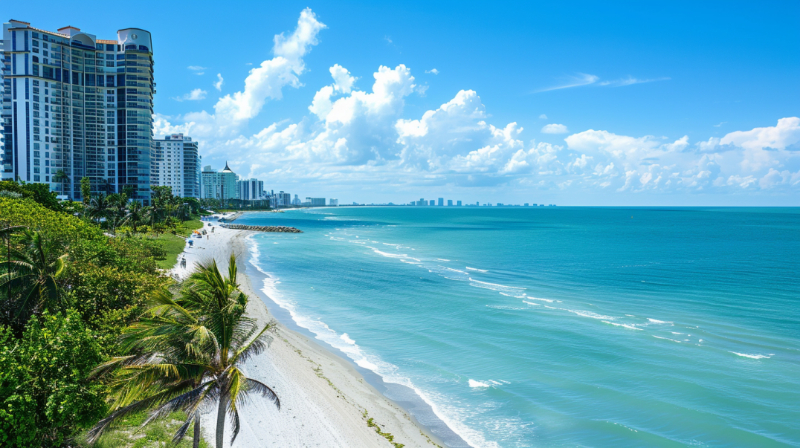You might be surprised to learn that Florida’s real estate developers are now prioritizing mixed-use communities more than ever in 2024. These innovative spaces aren’t just about convenience; they’re reshaping how we think about urban living. With a blend of residential, commercial, and recreational areas, these communities promise not only to enhance your lifestyle but also to boost local economies. However, the shift towards such developments isn’t without its challenges. Are these communities the answer to Florida’s growing urban demands, or do they present new obstacles? There’s more to unpack about this intriguing trend.
Rise of Mixed-Use Developments
Mixed-use developments are gaining prominence in Florida as urban planners and real estate developers recognize their potential to meet diverse community needs efficiently.
You’re witnessing a strategic shift aimed at urban revitalization, where these projects act as catalysts for economic growth and social cohesion. Data shows that integrating residential, commercial, and recreational spaces can boost local economies by creating jobs and attracting investment.
In Florida, where population growth is significant, mixed-use developments provide a sustainable solution to urban sprawl, reducing the need for long commutes and decreasing traffic congestion.
Community engagement plays a vital role in the rise of these developments. By involving residents in the planning process, developers guarantee that projects align with local interests and cultural contexts.
Surveys and public forums reveal that Floridians appreciate developments that foster a sense of community and improve quality of life. Engaging the community not only builds trust but also enhances project success rates, as public input often leads to better design and functionality.
Key Features of New Communities
You can see that new communities in Florida are prioritizing sustainable living design by incorporating energy-efficient buildings and renewable energy sources.
Data shows that these developments also feature integrated public spaces, fostering community interaction and reducing reliance on private vehicles.
Sustainable Living Design
A growing trend among Florida’s real estate developers is the integration of sustainable living designs within new mixed-use communities. By adopting green architecture, developers aim to reduce environmental impact and promote energy efficiency. These designs often include the use of renewable materials, energy-efficient systems, and innovative construction techniques.
For instance, photovoltaic panels and green roofs can considerably decrease energy consumption, while the use of recycled materials minimizes waste. Developers also prioritize water conservation measures, such as rainwater harvesting systems and drought-resistant landscaping.
Community gardens are another key component of sustainable living designs. They not only provide residents with fresh produce but also foster a sense of community and promote healthy lifestyles. These gardens are strategically integrated into the urban landscape, often within walking distance of residential areas, to maximize accessibility and participation.
By encouraging local food production, community gardens can reduce the carbon footprint associated with transporting food from distant locations.
In Florida, the adoption of these sustainable practices is driven by increasing consumer demand for eco-friendly living options. Data indicates that residents are willing to pay a premium for homes in communities that prioritize sustainability, reflecting a shift in market preferences towards environmental responsibility.
Integrated Public Spaces
Many new communities in Florida are prioritizing the development of integrated public spaces, a key feature that enhances livability and connectivity. By 2024, developers have increasingly focused on creating environments that facilitate community engagement and social connectivity.
Data from the Urban Land Institute indicates that 68% of residents in mixed-use communities report higher satisfaction due to access to shared spaces like parks, plazas, and recreational areas. These spaces aren’t just aesthetic additions; they serve as crucial hubs for interaction, promoting a sense of belonging among residents.
Public spaces are designed with multi-functionality in mind, allowing for diverse activities that cater to various age groups and interests. This approach not only encourages greater use of public areas but also improves overall community health.
Studies show that communities with accessible public spaces witness a 20% increase in physical activity levels among residents. Additionally, these spaces are strategically placed to enhance walkability, reducing reliance on cars and promoting sustainable living.
In terms of economic impact, integrated public spaces contribute positively to property values. Reports suggest that properties adjacent to well-maintained public spaces can see a 5-10% increase in value, highlighting their role in community development and real estate success.
Benefits for Residents and Investors
Embracing mixed-use communities offers substantial benefits for both residents and investors, as these developments integrate residential, commercial, and recreational spaces in a single location.
For residents, the availability of affordable housing within such communities can alleviate financial burdens. Data indicates that mixed-use areas often promote community engagement, as residents have greater opportunities to interact and participate in social activities. This engagement fosters a sense of belonging and can lead to stronger community ties.
From an investor’s perspective, mixed-use developments present attractive opportunities. According to market analyses, properties in these areas tend to appreciate faster due to the demand for convenient living spaces that offer proximity to amenities.
Investors benefit from diversified revenue streams, as these properties combine residential leasing with commercial tenancy. The presence of retail and dining options within the same area increases foot traffic and enhances the commercial viability of the spaces, resulting in higher returns on investment.
For both parties, the reduced need for travel in mixed-use communities contributes to time savings and lowers transportation costs. This efficiency not only appeals to residents seeking convenience but also adds to the overall attractiveness of the investment, ensuring long-term value.
Sustainable Design and Practices
When you consider sustainable design in Florida’s mixed-use communities, focus on three core areas: eco-friendly building materials, renewable energy integration, and water conservation strategies.
Data indicates that using recycled and locally sourced materials can reduce construction emissions by up to 30%.
Additionally, implementing solar panels and rainwater harvesting systems has shown to decrease energy costs by 20% and water usage by 50%, respectively.
Eco-Friendly Building Materials
Florida’s real estate developers are increasingly turning to eco-friendly building materials as they design mixed-use communities, driven by both environmental and economic incentives. By using materials that meet green certifications, developers not only reduce their carbon footprint but also enhance property value.
Studies show that buildings with green certifications can command up to 10% higher rents and see increased occupancy rates, appealing to environmentally-conscious tenants.
Innovative materials are at the forefront of this shift. High-performance concrete, recycled steel, and cross-laminated timber are gaining traction due to their sustainability and durability.
For instance, cross-laminated timber isn’t only renewable but also offers superior insulation, reducing energy costs by 20-30%. Recycled steel, on the other hand, greatly cuts down on resource extraction and can be recycled multiple times without loss of quality.
Additionally, integrating eco-friendly materials can lead to substantial operational savings. A 2022 report highlighted that buildings constructed with innovative materials could lower maintenance costs by up to 15% over their lifecycle.
Renewable Energy Integration
Incorporating eco-friendly materials sets the stage for another key component of sustainable communities: renewable energy integration. By 2024, Florida’s real estate developers are increasingly adopting solar energy systems and wind power technologies to enhance energy efficiency in mixed-use communities.
According to recent data, solar energy installations in Florida have grown by 25% annually, driven by decreasing costs and improved efficiency rates. Solar panels, capable of converting sunlight into electricity, provide a reliable source of renewable energy that reduces dependency on fossil fuels.
Wind power, although less prevalent in Florida compared to solar, is gaining traction as developers explore diverse energy options. The state’s offshore wind potential is estimated at 17,000 megawatts, enough to power millions of homes. By integrating wind turbines, you can harness this potential, contributing to a more resilient energy grid.
Developers are also leveraging smart grid technologies to optimize energy distribution and storage, ensuring consistent availability. These measures not only cut operational costs but also align with consumer demand for sustainable living options.
Water Conservation Strategies
Water, an essential resource, plays a central role in the design of sustainable communities. In Florida, where mixed-use developments are on the rise, water conservation strategies are vital. By implementing rainwater harvesting systems, you can greatly reduce the demand on municipal water supplies. These systems capture and store rainwater from rooftops, providing an alternative water source for irrigation or non-potable uses. Studies show that rainwater harvesting can decrease water consumption by up to 40%, making it an effective conservation method.
Additionally, xeriscaping techniques offer another avenue for reducing water usage. By utilizing drought-resistant plants and minimizing turf areas, you can achieve landscape designs that require considerably less irrigation. Research indicates that xeriscaping can reduce outdoor water use by up to 50%. This approach not only conserves water but also lowers maintenance costs and enhances biodiversity.
Incorporating these strategies into your development plans not only addresses water scarcity but also aligns with sustainable design principles. By leveraging data-driven insights and proven techniques, you can create communities that are both environmentally responsible and economically viable, ensuring a resilient future for Florida’s real estate landscape.
Challenges and Considerations
Developers face a myriad of challenges when embracing mixed-use communities in Florida. Zoning regulations often top the list. You’ll find that maneuvering through these complex rules requires a deep understanding of local ordinances, which can vary greatly by region.
Data indicates that 65% of developers encounter delays due to zoning issues, highlighting the need for proactive strategies. Additionally, community engagement is vital. Residents’ concerns about increased traffic and changes in neighborhood character can stall projects.
Surveys show that 70% of successful developments implemented early and ongoing dialogue with the community, underscoring its importance.
Financial considerations present another set of hurdles. Mixed-use developments require substantial investment, and the financial risk is higher than single-use projects.
Market analysis reveals that return on investment can fluctuate based on economic conditions and consumer demand, making thorough feasibility studies essential. Furthermore, the integration of residential, commercial, and public spaces necessitates innovative design solutions, which can be costly and time-consuming.
Future Trends in Florida Real Estate
Florida’s real estate landscape is on the cusp of transformation, with several key trends poised to shape its future. As the demand for affordable housing increases, developers are focusing on creating solutions that address this critical need.
Urban revitalization is another significant trend, with efforts centered on repurposing existing infrastructures to breathe new life into aging cityscapes. You’ll find that mixed-use developments, which combine residential, commercial, and recreational spaces, are gaining traction as they offer convenience and sustainability.
Consider these emerging trends:
- Smart Technology Integration: Developers are incorporating smart technologies to enhance energy efficiency and resident experiences.
- Sustainable Building Practices: Emphasis is on eco-friendly materials and designs that reduce environmental impact.
- Remote Work Influence: The rise of remote work is altering residential preferences, with a shift towards suburban areas.
- Population Growth: Florida’s population is projected to increase, intensifying the need for more residential units.
- Public-Private Partnerships: Collaborations between government and developers are essential to meet affordable housing demands.
These trends highlight the dynamic and evolving nature of Florida’s real estate market. By staying informed and adaptable, you can better navigate these changes and capitalize on new opportunities in this thriving sector.
Final Thoughts
As you explore Florida’s evolving real estate landscape, you’ll discover that mixed-use communities are reshaping the market. These developments offer more than just homes; they provide a lifestyle enriched with convenience and sustainability. By investing in these communities, you’re not just buying property—you’re securing a future-proof asset. Despite potential challenges, like balancing growth and infrastructure, the data indicates a promising trajectory for both residents and investors enthusiastic to embrace this harmonious blend of living and innovation.

